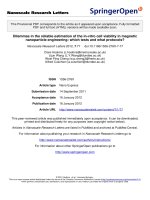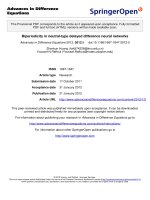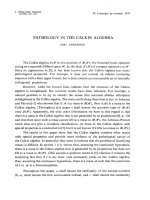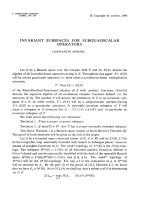Báo cáo toán học: "Forestation in hypergraphs: linear k-trees" pot
Bạn đang xem bản rút gọn của tài liệu. Xem và tải ngay bản đầy đủ của tài liệu tại đây (93.15 KB, 6 trang )
Forestation in hypergraphs: linear k-trees
Ojas Parekh
Department of Mathematics and Computer Science
Emory University, Atlanta, USA
Submitted: Sep 14, 2001; Accepted: Sep 1, 2003; Published: Sep 23, 2003
MR Subject Classifications: 05C65, 05E99
Abstract
We present a new proof of a result of Lov´asz on the maximum number of edges in
a k-forest. We also apply a construction used in our proof to generalize the notions
of a k-hypertree and k-forest to a class which extends some properties of trees, to
which both specialize when k=2.
1 Intro duction
Let X =[n]andF be a k-uniform hypergraph on X. We say an edge e ∈F crosses a
k-partition, X = X
1
˙
∪···
˙
∪X
k
,if|e ∩ X
i
| = 1 for 1 ≤ i ≤ k. F is a k-forest if for each
e ∈Fthere is some k-partition X = X
e
1
˙
∪···
˙
∪X
e
k
such that e is the unique edge crossing
it. What is the maximum number of edges in F?
This problem was initially posed to L´aszl´oLov´asz by Ronald Graham [2]. Lov´asz’s
novel algebraic proof appeared in [3] in 1979, and our proof remains algebraic in nature;
however, it relies on homogeneous multilinear polynomials over
2
rather than tensors.
The reader is encouraged to consult [1] for an introduction to and extensive applications
of linear algebra in combinatorics.
Theorem 1.1. A k-forest F on X has at most
n−1
k−1
edges.
Proof. We open with a few definitions. By
n−1
k−1
we mean the space of multilinear homo-
geneous polynomials of degree k − 1in
2
[x
1
, ,x
n−1
]. We make use of the shorthand
p(x)todenotep(x
1
, ,x
n−1
), where x =(x
1
, ,x
n−1
) ∈
n−1
2
and p ∈
n−1
k−1
. Finally,
for e ∈F,
e
denotes the incidence vector of e.
For each edge e ∈Fwe pick a k-partition π
e
=(X
e
1
, ,X
e
k
), such that e is the unique
edge crossing it. For simplicity we assume X
e
1
contains the element n. We then define a
polynomial,
p
e
(x
1
, ,x
n−1
)=
k
i=2
j∈X
e
i
x
j
.
the electronic journal of combinatorics 10 (2003), #N12 1
For each e in F, p
e
is in
n−1
k−1
, hence it suffices to demonstrate the independence of these
polynomials. To that end we seek to show that if e, f ∈F,thenp
e
(
f\{n}
)=1ifand
only if f = e.Wehave
p
e
(
f\{n}
)=
k
i=2
(|f ∩ X
e
i
| mod 2).
Clearly p
e
(
e\{n}
)=1. Iff = e there must be some i for which |f ∩ X
e
i
| =0,sincef does
not cross π
e
. In this case there also exists a j = i such that |f ∩ X
e
j
| mod 2 = 0. Thus
p
e
(
f\{n}
)=0.
Our agenda for the remainder of the paper is to first consider a generalization of k-
forests which preserves certain properties of forests and to then proceed to compare our
generalization with existing ones.
2Lineark-trees
In light of the result of the previous section a natural question arises. What can one
say about the maximum k-forests, those with exactly
n−1
k−1
edges? We could begin by
considering small examples. It is not difficult to verify that a 2-forest is indeed a forest.
In this case any maximal forest is a tree, which one may define in several ways. A basic
result in graph theory is that a graph which exhibits any two of
(i) acyclicity
(ii) exactly n − 1edges
(iii) connectivity
necessarily exhibits the third.
We already have analogues of (i) and (ii) that we could use in defining a k-tree for
k>2, and one might conjecture that for a k-uniform hypergraph H on X,anytwoof
(i’) H is a k-forest.
(ii’) H has exactly
n−1
k−1
edges.
(iii’) For each k-partition of X, H contains an edge that crosses it.
implies the third. Unfortunately this is not true.
Counterexample 2.1. The 3-uniform hypergraph
H = {{1, 2, 4}, {1, 2, 5}, {1, 3, 5}, {1, 4, 5}, {2, 3, 4}, {3, 4, 5}}
over {1, 2, 3, 4, 5} satisfies (ii’) and (iii’) but not (i’).
the electronic journal of combinatorics 10 (2003), #N12 2
Why does this generalization fail? Conditions (i’)-(iii’) extend the notion of a cut in a
graph, which is implicit in (i)-(iii), to that of a k-partition. We do have that a 2-partition
is indeed a cut; however, this is not the whole story. The proof of Theorem 1.1 offers
some insight into the matter. The multilinear polynomial space
n−1
1
consists entirely
of polynomials which correspond to 2-partitions; however, the reader may verify that
an analogous statement is not true for even
n−1
2
. Guided by this discrepancy, we say
an edge e ∈Hcrosses a polynomial p ∈
n−1
k−1
if p(
e\{n}
) = 1, and we relax (i’): The
hypergraph H is a linear k-forest (vs. a k-forest) if for each edge e ∈H,thereisa
polynomial p
e
∈
n−1
k−1
(vs. a k-partition) such that e is the unique edge in H crossing
p
e
. We accordingly strengthen (iii’): The hypergraph H is linearly k-connected,orsimply
k-connected, if for each polynomial p ∈
n−1
k−1
, there is an edge e ∈Hwhich crosses p.The
scrutinizing reader might have sensed something amiss in the preceding definitions. The
polynomial space
n−1
k−1
is defined with respect to a distinguished element n ∈ X.
Lemma 2.2. A hypergraph is a linear k-forest or k-connected independently of the choice
of distinguished element used in defining
n−1
k−1
.
Proof. Let p(x
1
, ,x
n−1
) ∈
n−1
k−1
. We will demonstrate a p
(x
1
, ,x
i−1
,x
i+1
, ,x
n
) ∈
n
k−1
such that {e ∈
X
k
| p(
e\{n}
)=1} = {e ∈
X
k
| p
(
e\{i}
)=1}. We divide p by x
i
to yield p = x
i
q + r where q ∈
n−1
k−2
, r ∈
n−1
k−1
, and neither contain the variable x
i
.We
can represent q as a sum of monomials, that is there exist sets Y
s
∈
X\{i,n}
k−2
for s in some
index set S such that q =
s∈S
j∈Y
s
x
j
. Notice that an edge crosses the polynomial
(
j∈Y
s
x
j
)(
j∈Y
s
∪{i}
x
j
) if and only if it crosses the monomial x
i
(
j∈Y
s
x
j
). This provides
us the construction we seek, and we set
p
(x
1
, ,x
i−1
,x
i+1
, ,x
n
)=r +
s∈S
j∈Y
s
x
j
j∈Y
s
∪{i}
x
j
.
We will henceforth use
n−1
k−1
to refer to a multilinear polynomial space in n−1variables,
the indices of which will be clear from context. We now have the following.
Theorem 2.3. For H,ak-uniform hypergraph on X, any two of
(i) H is a linear k-forest.
(ii) H has exactly
n−1
k−1
edges.
(iii) H is k-connected.
implies the third.
the electronic journal of combinatorics 10 (2003), #N12 3
Proof.
(i),(ii) implies (iii): For each edge e let p
e
be a polynomial for which e is the unique edge
in H crossing p
e
. For a polynomial p ∈
n−1
k−1
,letH(p)denote{e ∈H|e crosses p}.
As in the proof of Theorem 1.1 we have the independence of the polynomials p
e
for
e ∈H, hence |{p
e
| e ∈H}|=
n−1
k−1
by (ii). The set {p
e
| e ∈H}is a basis for
n−1
k−1
,
so for any q ∈
n−1
k−1
we must have H(q) = ∅.
(ii),(iii) implies (i): First we establish p = q implies H(p) = H(q), for polynomials
p, q ∈
n−1
k−1
. Proceeding by contrapositive, if H(p)=H(q)thenH(p +q)=∅, hence
p = q.Thereareexactly2
(
n−1
k−1
)
− 1 polynomials in
n−1
k−1
and |H| =
n−1
k−1
, so by (iii)
{H(p) | p ∈
n−1
k−1
} =2
H
\ {∅},where2
H
is the powerset of H. Thus for each edge
e ∈H, {e}∈{H(p) | p ∈
n−1
k−1
}.
(iii),(i) implies (ii): From the proof of the first part we have (i) implies |H| ≤
n−1
k−1
;
from that of the second we have (iii) implies |H| ≥
n−1
k−1
.
We are finally in position to call a hypergraph T that satisfies any two conditions
above a linear k-tree. The third part of the proof of the theorem hints at two other
characterizations of linear k-trees.
Theorem 2.4.
(i) Every k-connected hypergraph contains a linear k-tree.
(ii) Every linear k-forest is contained in a linear k-tree.
Proof.
(i): For the sake of contradiction, let H be a minimal k-uniform hypergraph over X
that is k-connected but does not contain a linear k-tree. We let
(H)represent
{p ∈
n−1
k−1
| some e ∈ H crosses p},whereH ⊆H; we omit braces for singleton
arguments. Since H is not a linear k-forest, there is some e ∈Hsuch that
(e) ⊆
(H\{e}), hence H\{e} is also a counterexample.
(ii): For the sake of contradiction, let H be a maximal k-uniform hypergraph over X that
is a linear k-forest but is not contained in a linear k-tree. Since H is not k-connected,
there is some p ∈
n−1
k−1
such that H(p)=∅.Letf ∈
X
k
be some set such that
p(
f\{n}
) = 1, and for e ∈Hlet p
e
be a polynomial such that H(p
e
)={e}.Weset
p
f
= p, and for each edge e ∈H,weset
p
e
=
p
e
+ p if p
e
(
f\{n}
)=1
p
e
otherwise
,
which renders e the unique edge in H∪{f} crossing p
e
and H∪{f} a counterexample.
the electronic journal of combinat orics 10 (2003), #N12 4
Thus we may also think of linear k-trees as maximal linear k-forests or minimally
k-connected hypergraphs.
3 All trees are not created equal
A linear k-tree is only one of a multitude of possible generalizations of trees to hyper-
graphs; in this section we explore the connection between linear k-trees and a generaliza-
tion which exists in the literature.
The combinatorial structure known as a k-hypertree was introduced in [4] as a tool
for developing Bonferroni type inequalities. A k-hypertree is a k-uniform hypergraph T
on X such that for k =2,T is a tree with vertex set X and for k ≥ 3, T is defined
recursively as follows:
(i) If X = {1, ,k} then T has a unique edge {1, ,k}.
(ii) If |X|≥k + 1 then there exists an element i ∈ X such that if e
1
, ,e
q
denote all
edges containing i then e
1
\{i}, ,e
q
\{i} induce an (k − 1)-hypertree with vertex set
X \{i} and the remaining edges of T induce a k-hypertree with vertex set X \{i}.A
k-hypertree has exactly
n−1
k−1
edges.
The notion was augmented [5] by imposing a total ordering µ on X, yielding several
nice characterizations of k-hypertrees which generalize properties of trees. We show that
linear k-trees generalize k-hypertrees. We denote the classes of linear k-trees and k-
hypertrees on X by LKT (k, n)andHT (k,n) respectively.
Theorem 3.1. HT (k,n) ⊂LKT(k, n).
Proof. We show inclusion by induction. We have that HT (k,k)=LKT (k, k), so let us
consider some T∈HT(k,n) for k<n.Since|T | =
n−1
k−1
, by Theorem 2.3 it suffices to
show T is k-connected. Let l ∈ X be an element such that T
l
= {e \{l}|l ∈ e ∈T}and
T
¯
l
= {e ∈T |l/∈ e} are respectively (k − 1)- and k-hypertrees over X \{l}.
We seek to show that for a polynomial p(x
1
, ,x
n−1
) ∈
n−1
k−1
thereissomeedgein
T = T
l
˙
∪T
¯
l
that crosses it. Note that we may assume l = n by Lemma 2.2. Dividing by
x
l
gives us p = x
l
q(x
1
, ,x
l−1
,x
l+1
, ,x
n−1
)+r(x
1
, ,x
l−1
,x
l+1
, ,x
n−1
). If r ≡ 0
then e ∪{l} crosses p = x
l
q for some e ∈T
l
,sinceT
l
∈KT(k − 1,n− 1) by the induction
hypothesis. Otherwise some e ∈T
¯
l
crosses r,sinceT
¯
l
∈KT(k, n − 1) by the induction
hypothesis. In this case l/∈ e, hence e crosses p = x
l
q + r.
As for strict inclusion, we leave it to the reader to verify that
T =
{1, 2, 3}, {1, 2, 4}, {1, 2, 6}, {1, 4, 5}, {1, 5, 6},
{2, 3, 5}, {2, 3, 6}, {3, 4, 5}, {3, 4, 6}, {4, 5, 6}
is a linear 3-tree but not a 3-hypertree.
The class LKT (k,n) may be a practically significant generalization of HT (k, n). Given
a cost function c :
X
k
→
+
,itisNP-complete to decide whether there is a k-hypertree
of cost at most l for n>k≥ 3 [6]. This is known as the minimum spanning k-hypertree
the electronic journal of combinatorics 10 (2003), #N12 5
problem and for k = 2 reduces to the polynomial time solvable minimum spanning tree
problem. Replacing ‘k-hypertree’ with ‘linear k-tree’ in the above definition drastically
reduces the complexity of the problem. By Theorems 2.4 and 2.3 the linear k-forests on
X comprise a matroid, hence we can apply a greedy algorithm to solve the minimum
spanning linear k-tree problem in polynomial time for constant k.
We close by offering a conjecture. A k-tree is a k-forest of size
n−1
k−1
.WeletKT (k, n)
denote the class of k-trees on X. From Theorem 2.3, Counterexample 2.1, and the fact
that {e ∈
X
k
| 1 ∈ e}∈HT(k,n) ∩KT(k, n), we derive the following properties.
KT (k, n) ⊂LKT(k, n)(1)
HT (k, n) \KT(k, n) = ∅ (2)
HT (k, n) ∩KT(k, n) = ∅ (3)
Unfortunately these leave the precise interaction of HT (k, n)andKT (k, n) uncertain.
Yet if one could show that for every T∈KT(k, n)thereissomei ∈ X that is contained
in exactly
n−2
k−2
edges, then induction would yield the following.
Conjecture 3.2. KT (k, n) ⊂HT(k,n).
Acknowledgements
The author is grateful to Tom Bohman for exposing him to the tools and the trade.
References
[1] L. Babai and P. Frankl. Linear Algebra Methods in Combinatorics. Dept. of Computer
Science, The Univ. of Chicago, Chicago, 1992.
[2] R. Graham. Personal Communication. 2000.
[3] L. Lov´asz. Topological and Algebraic Methods in Graph Theory. In Graph theory
and related topics (Proc. Conf., Univ. Waterloo, Waterloo, Ont., 1977), pp. 1–14,
Academic Press, New York-London, 1979.
[4] I. Tomescu. Hypertrees and Bonferroni inequalities. J. Combin. Theory Ser. B,
41:209–217, 1986.
[5] I. Tomescu. Ordered h-Hypertrees. Discrete Mathematics, 195:241–248, 1992.
[6] I. Tomescu and M. Zimand. Minimum spanning hypertrees. Discrete Appl. Math.,
54.1:67–76, 1994.
the electronic journal of combinatorics 10 (2003), #N12 6









